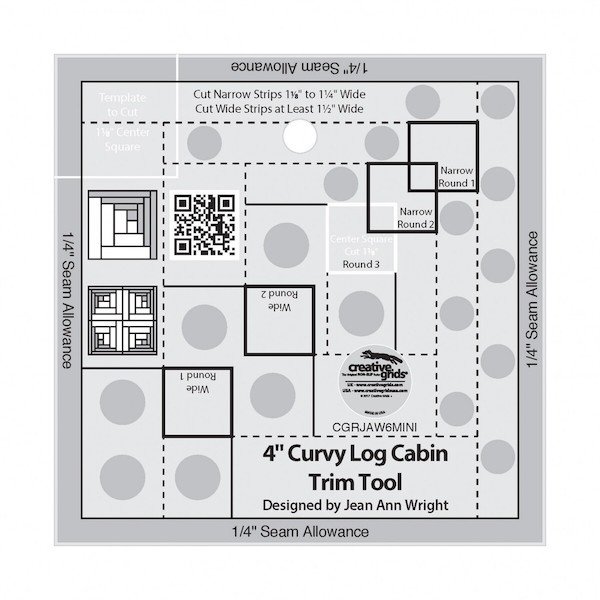The Six-Hour Block
Welcome to the world of the spatially impaired quilter. It took me most of yesterday to make this:
Six hours to produce a quilt block that should have taken a fraction of that time to make. I am not a novice quilter. (Don’t look at that one wonky seam. I was tired when I sewed that.)
I’ve had the Creative Grids Curvy Log Cabin quilt ruler—this is the 8" size—for a while. I also have a couple of overflowing bags of strips. I’m not particularly fascinated by Log Cabin quilts, despite the fact that I seem to make a lot of them. They just happen to be good for using up leftover strips of fabric.
The reason this is “curvy” is because the logs on either side of the center square are different widths. If you could imagine that I had made four of these (correctly) and had sewn them together, you would see that the red logs make a circle on a background of white.
I did make four of these, incorrectly. That is what took most of the first five hours. I didn’t see the problem until I had sewn the four blocks together, and even then, it took me a few minutes of staring at the larger block to figure out what was wrong. I lay my mistake entirely at the feet of the person who wrote the instructions for the Curvy Log Cabin Ruler. The ruler looks like this:
It comes with a front-and-back page of instructions. The instructions are in two-color monochrome (black and red on white). The steps are not numbered. There are “tips” which really ought to be numbered steps. The instructions do not indicate which fabric should be which. Labeling them as Fabric A and Fabric B would have helped, as would calling one of them “background.”
Even after making five of these blocks, I still do not understand what the first “step” in the instructions—called a “tip”—means.
Basically, what happened was that I used red for the starting block instead of white, because I was looking at the monochrome black-and-red instructions and that is what my brain saw. I got a red circle in my completed 16” block, yes, but it was a weird-looking, squared-off circle.
Could I have gone to YouTube and watched a video on how to make this block? Definitely, but I am old-school and of the opinion that if you cannot communicate to the end user how to use your product successfully, something is wrong. We made things before the existence of the internet, you know.
Nicole Sauce talked about this in one of her recent podcasts. She just completed a kitchen renovation and had a difficult time with one of the products because it came with no instructions. She searched high and low and never found any. She commented that the internet used to be a great place to go to get instructions for products, and now manufacturer websites consist mostly of marketing materials. I had the same experience when I bought a Scarlett Solo Box a few months ago for the podcast. I still haven’t used it because it came with no instructions in the box. The manufacturer website is a collection of slick, glossy photos showing people using it, but not explaining HOW they are using it. I set it up once, the way I thought it should go, and the audio was worse than when I just use my Rode microphone plugged into my computer. I don’t know how to adjust the Solo Box because it didn’t come with any instructions.
At this point, I am not sure I want to make any more of these blocks. I may have scratched this particular itch. I do know how to use the ruler now, though. 😐
***************
I host my podcast audio files at Buzzsprout. I have been quite happy with them so far, probably because they have extensive documentation on how to use their service. Yesterday, they sent me a year-end summary of my podcast downloads. They submit my podcast to the various podcatchers and aggregate the stats for me. I produced 14 episodes in 2023, which I am calling Season 1. The podcast was downloaded in 11 different countries. The US city with the most episode downloads was Seattle. (The husband wondered if DD#2 was making all of her friends listen to her mother’s podcast but I doubt that.) The total number of downloads was 946 and the majority of listeners—over 60%—are using Apple Podcasts.
I’m happy with those numbers, especially considering I just launched this project. I feel like I can go forward in a more deliberate manner now, and I am excited about some of the interviews I have scheduled.


